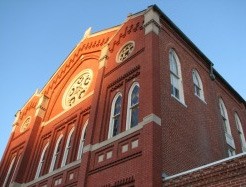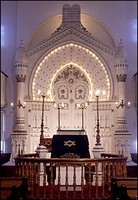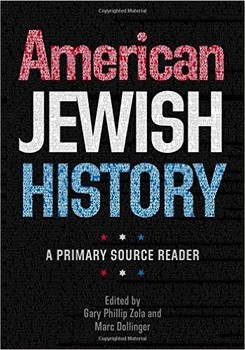B'nai Israel Congregation
Introduction
Text-to-speech Audio
Images
B'nai Israel Synagogue

Synagogue interior

American Jewish History, book

Backstory and Context
Text-to-speech Audio
Today, the Chizuk Amuno Congregation is located northwest of Baltimore. It is affiliated with Conservative Judaism and defines itself as “a traditional, Conservative, egalitarian congregation. It supports the Jewish Theological Seminary of America (JTSA) and the United Synagogue of Conservative Judaism (USCJ). Conservative Judaism holds Religious Law (Halakha) as binding but also considers its need to necessarily be amended according to modern times.
B’nai Israel was known officially as a “Russian Congregation”; however, many of the congregation’s founding members, including Joseph Hyman, Joseph Stein, Koppel Hyman, Julius Krulewitch, Isaac Jacob, and Louis Sakolski, were actually Polish. In 1880, there were 10,000 Jews living in Baltimore. This number would rise to 25,000 over the next twenty years due to a large influx of Jews emigrating from Eastern Europe. The congregation met in rented space for five years before moving to their first permanent building, a remodeled schoolhouse on N. Exeter Street.
Modern Orthodox Judaism, as can be found in the B’nai Israel congregation, strives to find compatibility with Jewish values, Jewish law, and the modern, secular world. In Modern Orthodoxy in America: Possibilities for a Movement Under Siege, William B. Helmreich and Reuel Shinnar’s describe the "overall approach" of Modern Orthodoxy as follows:
...The belief that one can and should be a full member of modern society, accepting the risks to remaining observant, because the benefits outweigh those risks. What it means is that a Jew can study the writings of Christian philosophy, learn any scientific theory he or she wants to, attend a concert at which women sing (accepting the view of some halakhic authorities that it is permitted), interact with non-Jews, and do pretty much what others do, even while leading a fully observant life. (see 'sources' below for a link to the whole text).
Sources
"B'nai Israel Synagogue." Jewish Museum of Maryland. Accessed February 11, 2017. http://jewishmuseummd.org/visiting/bnai-israel-synagogue/.
Shoken, Fred. "A History of the B’nai Israel Congregation of Baltimore City." B'nai Israel: The Downtown Synagogue. Accessed February 11, 2017. http://www.jewishdowntown.org/history.html.
Helmreich, William. Shinnar, Reuel. Modern Orthodoxy in America: Possibilities for a Movement under Siege. Jerusalem Letter / Viewpoints. Jerusalem Center for Public Affairs (JCPA). 1 June 1998: http://www.bjpa.org/Publications/details.cfm?PublicationID=2228.
